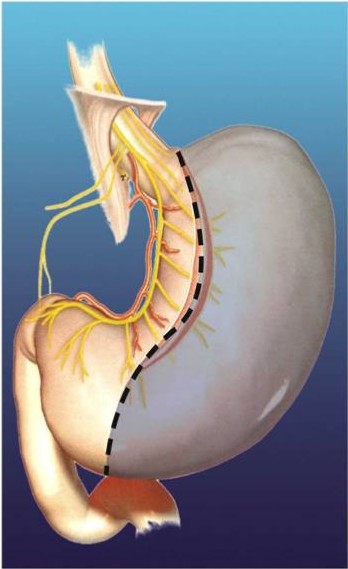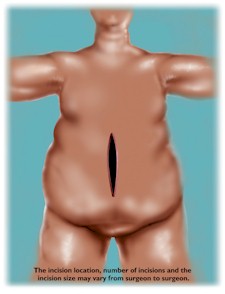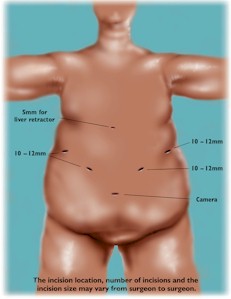Sleeve
INTRODUCTION
The Sleeve Gastrectomy is also called vertical gastroplasty, Gastric Reduction and even Vertical Gastroplasty It reduces the volume of the stomach by removing of a part of the stomach. Weight loss is generated by restricting the amount of food that can be eaten without any bypass of the intestines or malabsorption. Also the hungry feeling will diminish as the part of the stomach were these receptors are located will be removed. This procedure is done by laparoscopy. Because a part of the stomach will be removed this procedure is irreversible.!
PREPARATION TO THE PROCEDURE
When you are well informed and choose to have a ‘Sleeve-Gastrectomy’ then the following investigations have to take place:
1. Laboratory / Blood tests 2. Ultrasound of your abdomen 3. Electrocardiogram with cardiac check-up 4. Chest X-ray with pulmonary check-up 5. Gastroscopy 6. Consultation dietician
In case of regular medication usage one has to inform their surgeon, especially in case of blood thinners (aspirine, anti coagulants, anti-inflammatory drugs, http://www.ncpainmanagement.com/BloodThinners.htm ) as these need to be stopped before surgery.
On the day of surgery you will have to remain sober. If necessary some medication can be taken with a little water.
This procedure is not reversible !
PROCEDURE
With a Sleeve-gastrectomy a large part of the stomach is surgically removed by laparoscopy. This part is called ‘the greater curvature’ and is located on the left side of the stomach..

The stomach has normally the shape of a rugbt-ball but after surgery the shape is more like a banana. The exit of the stomach remains the same.
The volume after surgery is approximately 100 to 150 cc. It is a restrictive operation and can best be compared with the ‘Gastric Banding’.
SURGERY THROUGH LAPAROSCOPIE
Weight loss surgery is done by laparoscopy also called minimally invasive surgery or keyhole surgery . It is a modern surgical technique in which operations in the abdomen are performed through small incisions (usually 2-3cm) as compared to larger incisions needed in traditional surgical procedures.
The abdomen is inflated creating sort of ‘air bubble’ as working space. Through 4 or 5 small incisions a camera and small instruments are placed inside your abdomen. The rest of the procedure takes place inside the abdomen.
After the surgery when a patient awakes he or she can experience pain in the shoulders due to the insufflation. Normally this pain disappears within a couple of days.
COMPLICATIONS
1. During surgery or while hospitalized.
As with any surgery, there can be complications. These can occur during surgery, while hospitalized or after discharge. This list can include:
• Bleedings • Injury to the abdominal organs.
• Stomach ulcers or perforation.
• Deep vein thrombophlebitis with even non-fatal pulmonary embolus
• Gastrointestinal (sub)obstruction
• Urinary infection
• Woundinfection
• Pneumonia
• Heart attack
This list is not complete. There is even a very small risk of dying due to complications.
Special measures are taken to minimize the risk of complications. Complications which lengthen the hospitalisation are rare.
2. Late complications are very rare
DIET AFTER SURGERY
1. Adjusting eating behaviour
• Eat at diner table
• Have small meals and take your time, use 3 main meals and a few healthy snacks.
• Stop eating after first sensation of satiety, More bites can lead to vomiting.
• Drink slowly but not during a meal.
• Avoid alcohol, drinks containing sugar, sweets, cookies, chocolate.
• Avoid using pure sugar.
• Limit use of fat in meals.
Adaptation of eating after a Sleeve Gastrectomy goes in different steps from liquids to mixed to protein rich solid food. The meals are much smaller than normal and food needs to be much softer from texture. In every step it is important to drink enough water.
Step 1:
Liquid meals during first 14 days
Use:
• Low fat milk
• Low fat yoghurt
• Vegetable juices
• Soup (blended) or bouillon
• Proteindrinks, etc
Step 2.
Slowly change to mixed foods by adding in the next 14 days
• mashed potatoes,
• cooked/mixed vegetables
• cooked fish, eggs
If this goes well then mixed meat, toasted bread and other food can be added, using small amounts. (= step 3)



